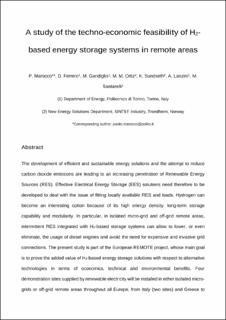| dc.description.abstract | The development of efficient and sustainable energy solutions and the attempt to reduce carbon dioxide emissions are leading to an increasing penetration of Renewable Energy Sources (RES). Effective Electrical Energy Storage (EES) solutions need therefore to be developed to deal with the issue of fitting locally available RES and loads. Hydrogen can become an interesting option because of its high energy density, long-term storage capability and modularity. In particular, in isolated micro-grid and off-grid remote areas, intermittent RES integrated with H2-based storage systems can allow to lower, or even eliminate, the usage of diesel engines and avoid the need for expensive and invasive grid connections. The present study is part of the European REMOTE project, whose main goal is to prove the added value of H2-based energy storage solutions with respect to alternative technologies in terms of economics, technical and environmental benefits. Four demonstration sites supplied by renewable electricity will be installed in either isolated micro-grids or off-grid remote areas throughout all Europe, from Italy (two sites) and Greece to Norway. The aim of this work is to perform a techno-economic analysis and demonstrate the effectiveness of the hybrid H2-battery Power-To-Power (P2P) solution in reducing the usage of external sources (e.g., diesel engines or grid) in a cost-effective way, with different load and environment conditions. The economic viability of the considered scenarios was outlined by computing the Levelized Cost Of Energy (LCOE). For each of the four sites, the innovative renewable configuration was compared with the current/alternative one. The REMOTE project partners provided main input data for the analysis: techno-economic data from the technology suppliers, whereas electricity consumption and RES production values from the end users of the four isolated locations. LCOE values derived using cost inputs both from REMOTE and literature are presented for a comparison. Results from the energy simulations revealed that the need for an external source is significantly reduced thanks to RES together with the hybrid storage system. Moreover, for all the four sites the renewable solution was shown to be more profitable than the current or alternative one, either in the short term or in the longer term. | en_US |

